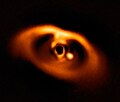Habitability and Properties
It orbits an M-type star. Its radius is 1.32 ± 0.09 times that of Earth. [1] It orbits at 0.177 AU [3] with an orbital period of 34.9893 days. [1] Because of its proximity to its star, it is likely to be tidally locked, meaning one side always facing the star, and one side always facing away. This means one side is blistering hot, and one side is bitter cold. However, in between those hostile zones, there would be a sliver of habitability. If it has a thick enough atmosphere, the sliver may even be global.[ citation needed ]
| Earth | Kepler-395c |
|---|---|
 |  |
